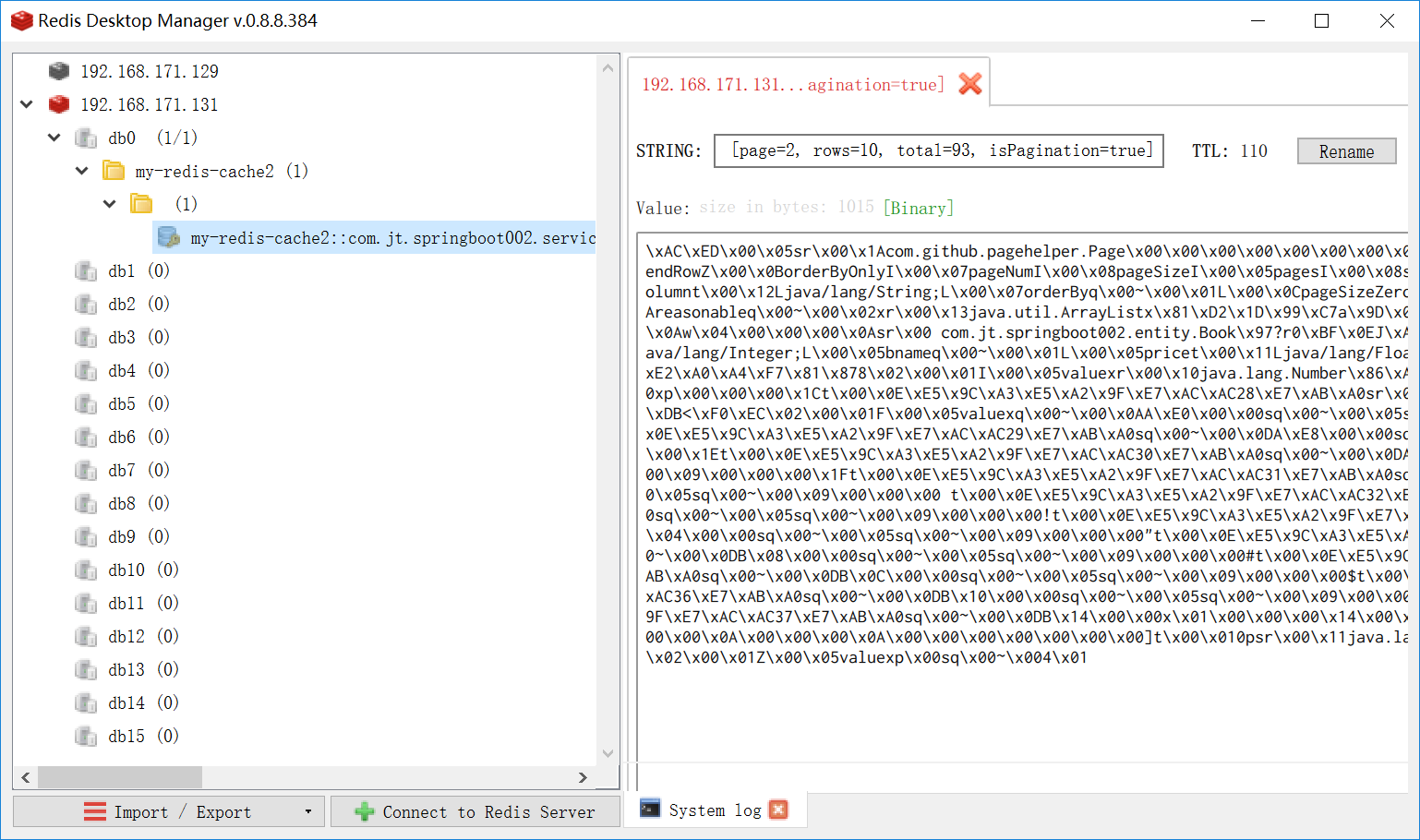1、SpringBoot配置类
2、SpringBoot整合redis及其注解式开发
@Configuration
@Configuration底层是含有@Component ,所以@Configuration 具有和 @Component 的作用。
@Configuration可理解为用spring的时候xml里面的<beans>标签。
注:
1) 配置类必须以类的形式提供(不能是工厂方法返回的实例),允许通过生成子类在运行时增强(cglib 动态代理)。
2) 配置类不能是 final 类(没法动态代理)。
3) 配置注解通常为了通过 @Bean 注解生成 Spring 容器管理的类。
4) 配置类必须是非本地的(即不能在方法中声明,不能是 private)。
5) 任何嵌套配置类都必须声明为static。
6) @Bean方法不能创建进一步的配置类(也就是返回的bean如果带有@Configuration,也不会被特殊处理,只会作为普通的 bean)。
@EnableCaching
1) @EnableCaching注解是spring framework中的注解驱动的缓存管理功能。自spring版本3.1起加入了该注解。
2) 如果你使用了这个注解,那么你就不需要在XML文件中配置cache manager了。
3) 当你在配置类(@Configuration)上使用@EnableCaching注解时,会触发一个post processor,这会扫描每一个spring bean,查看是否已经存在注解对应的缓存。如果找到了,就会自动创建一个代理拦截方法调用,使用缓存的bean执行处理。
@Bean
@Bean可理解为用spring的时候xml里面的<bean>标签。
注:
1) @Bean注解在返回实例的方法上,如果未通过@Bean指定bean的名称,则默认与标注的方法名相同;
2) @Bean注解默认作用域为单例singleton作用域,可通过@Scope(“prototype”)设置为原型作用域;
3) 既然@Bean的作用是注册bean对象,那么完全可以使用@Component、@Controller、@Service、@Repository等注解注册bean(在需要注册的类上加注解),当然需要配置@ComponentScan注解进行自动扫描。
导入POM依赖
<dependency>
<groupId>org.springframework.boot</groupId>
<artifactId>spring-boot-starter-data-redis</artifactId>
</dependency>
<dependency>
<groupId>redis.clients</groupId>
<artifactId>jedis</artifactId>
</dependency>
配置application.yml
redis: database: 0 host: 192.168.171.131 port: 6379 password: 123456 jedis: pool: max-active: 100 max-idle: 3 max-wait: -1 min-idle: 0 timeout: 1000
创建RedisConfig
RedisConfig类用于Redis数据缓存。
//继承CachingConfigurerSupport,为了自定义生成KEY的策略。可以不继承。
package com.jt.springboot002.config; import com.fasterxml.jackson.annotation.JsonAutoDetect; import com.fasterxml.jackson.annotation.PropertyAccessor; import com.fasterxml.jackson.databind.ObjectMapper; import org.springframework.cache.CacheManager; import org.springframework.cache.annotation.CachingConfigurerSupport; import org.springframework.cache.annotation.EnableCaching; import org.springframework.cache.interceptor.KeyGenerator; import org.springframework.context.annotation.Bean; import org.springframework.context.annotation.Configuration; import org.springframework.data.redis.cache.RedisCacheConfiguration; import org.springframework.data.redis.cache.RedisCacheManager; import org.springframework.data.redis.connection.RedisConnectionFactory; import org.springframework.data.redis.core.RedisTemplate; import org.springframework.data.redis.core.StringRedisTemplate; import org.springframework.data.redis.serializer.Jackson2JsonRedisSerializer; import org.springframework.data.redis.serializer.StringRedisSerializer; import java.lang.reflect.Method; import java.time.Duration; import java.util.HashMap; import java.util.HashSet; import java.util.Map; import java.util.Set; /** * redis配置类 **/ @Configuration @EnableCaching//开启注解式缓存 //继承CachingConfigurerSupport,为了自定义生成KEY的策略。可以不继承。 public class RedisConfig extends CachingConfigurerSupport { /** * 生成key的策略 根据类名+方法名+所有参数的值生成唯一的一个key * * @return */ @Bean @Override public KeyGenerator keyGenerator() { return new KeyGenerator() { @Override public Object generate(Object target, Method method, Object... params) { StringBuilder sb = new StringBuilder(); sb.append(target.getClass().getName()); sb.append(method.getName()); for (Object obj : params) { sb.append(obj.toString()); } return sb.toString(); } }; } /** * 管理缓存 * * @param redisConnectionFactory * @return */ @Bean public CacheManager cacheManager(RedisConnectionFactory redisConnectionFactory) { //通过Spring提供的RedisCacheConfiguration类,构造一个自己的redis配置类,从该配置类中可以设置一些初始化的缓存命名空间 // 及对应的默认过期时间等属性,再利用RedisCacheManager中的builder.build()的方式生成cacheManager: RedisCacheConfiguration config = RedisCacheConfiguration.defaultCacheConfig(); // 生成一个默认配置,通过config对象即可对缓存进行自定义配置 config = config.entryTtl(Duration.ofMinutes(1)) // 设置缓存的默认过期时间,也是使用Duration设置 .disableCachingNullValues(); // 不缓存空值 // 设置一个初始化的缓存空间set集合 Set<String> cacheNames = new HashSet<>(); cacheNames.add("my-redis-cache1"); cacheNames.add("my-redis-cache2"); // 对每个缓存空间应用不同的配置 Map<String, RedisCacheConfiguration> configMap = new HashMap<>(); configMap.put("my-redis-cache1", config); configMap.put("my-redis-cache2", config.entryTtl(Duration.ofSeconds(120))); RedisCacheManager cacheManager = RedisCacheManager.builder(redisConnectionFactory) // 使用自定义的缓存配置初始化一个cacheManager .initialCacheNames(cacheNames) // 注意这两句的调用顺序,一定要先调用该方法设置初始化的缓存名,再初始化相关的配置 .withInitialCacheConfigurations(configMap) .build(); return cacheManager; } @Bean public RedisTemplate<Object, Object> redisTemplate(RedisConnectionFactory connectionFactory) { RedisTemplate<Object, Object> template = new RedisTemplate<>(); template.setConnectionFactory(connectionFactory); //使用Jackson2JsonRedisSerializer来序列化和反序列化redis的value值(默认使用JDK的序列化方式) Jackson2JsonRedisSerializer serializer = new Jackson2JsonRedisSerializer(Object.class); ObjectMapper mapper = new ObjectMapper(); mapper.setVisibility(PropertyAccessor.ALL, JsonAutoDetect.Visibility.ANY); mapper.enableDefaultTyping(ObjectMapper.DefaultTyping.NON_FINAL); serializer.setObjectMapper(mapper); template.setValueSerializer(serializer); //使用StringRedisSerializer来序列化和反序列化redis的key值 template.setKeySerializer(new StringRedisSerializer()); template.afterPropertiesSet(); return template; } @Bean public StringRedisTemplate stringRedisTemplate(RedisConnectionFactory factory) { StringRedisTemplate stringRedisTemplate = new StringRedisTemplate(); stringRedisTemplate.setConnectionFactory(factory); return stringRedisTemplate; } }
在整合ehcache的时候,会有一个配置文件spring-ehcache.xml如下
<!-- 使用ehcache缓存 -->
<bean id="cacheManagerFactory" class="org.springframework.cache.ehcache.EhCacheManagerFactoryBean">
<property name="configLocation" value="classpath:ehcache.xml"/>
<property name="shared" value="true"></property>
</bean>
<!-- 默认是cacheManager -->
<bean id="cacheManager" class="org.springframework.cache.ehcache.EhCacheCacheManager">
<property name="cacheManager" ref="cacheManagerFactory"/>
</bean>
ehcache.xml
<!--defaultCache:默认的管理策略-->
<!--eternal:设定缓存的elements是否永远不过期。如果为true,则缓存的数据始终有效,如果为false那么还要根据timeToIdleSeconds,timeToLiveSeconds判断-->
<!--maxElementsInMemory:在内存中缓存的element的最大数目-->
<!--overflowToDisk:如果内存中数据超过内存限制,是否要缓存到磁盘上-->
<!--diskPersistent:是否在磁盘上持久化。指重启jvm后,数据是否有效。默认为false-->
<!--timeToIdleSeconds:对象空闲时间(单位:秒),指对象在多长时间没有被访问就会失效。只对eternal为false的有效。默认值0,表示一直可以访问-->
<!--timeToLiveSeconds:对象存活时间(单位:秒),指对象从创建到失效所需要的时间。只对eternal为false的有效。默认值0,表示一直可以访问-->
<!--memoryStoreEvictionPolicy:缓存的3 种清空策略-->
<!--FIFO:first in first out (先进先出)-->
<!--LFU:Less Frequently Used (最少使用).意思是一直以来最少被使用的。缓存的元素有一个hit 属性,hit 值最小的将会被清出缓存-->
<!--LRU:Least Recently Used(最近最少使用). (ehcache 默认值).缓存的元素有一个时间戳,当缓存容量满了,而又需要腾出地方来缓存新的元素的时候,那么现有缓存元素中时间戳离当前时间最远的元素将被清出缓存-->
<defaultCache eternal="false" maxElementsInMemory="1000" overflowToDisk="false" diskPersistent="false"
timeToIdleSeconds="0" timeToLiveSeconds="600" memoryStoreEvictionPolicy="LRU"/>
ssm框架中如果整合redis,那么会有个spring-redis.xml配置文件,里面的配置内容如下
<!-- 1. 引入properties配置文件 --> <!--<context:property-placeholder location="classpath:redis.properties" />--> <!-- 2. redis连接池配置--> <bean id="poolConfig" class="redis.clients.jedis.JedisPoolConfig"> <!--最大空闲数--> <property name="maxIdle" value="${redis.maxIdle}"/> <!--连接池的最大数据库连接数 --> <property name="maxTotal" value="${redis.maxTotal}"/> <!--最大建立连接等待时间--> <property name="maxWaitMillis" value="${redis.maxWaitMillis}"/> <!--逐出连接的最小空闲时间 默认1800000毫秒(30分钟)--> <property name="minEvictableIdleTimeMillis" value="${redis.minEvictableIdleTimeMillis}"/> <!--每次逐出检查时 逐出的最大数目 如果为负数就是 : 1/abs(n), 默认3--> <property name="numTestsPerEvictionRun" value="${redis.numTestsPerEvictionRun}"/> <!--逐出扫描的时间间隔(毫秒) 如果为负数,则不运行逐出线程, 默认-1--> <property name="timeBetweenEvictionRunsMillis" value="${redis.timeBetweenEvictionRunsMillis}"/> <!--是否在从池中取出连接前进行检验,如果检验失败,则从池中去除连接并尝试取出另一个--> <property name="testOnBorrow" value="${redis.testOnBorrow}"/> <!--在空闲时检查有效性, 默认false --> <property name="testWhileIdle" value="${redis.testWhileIdle}"/> </bean> <!-- 3. redis连接工厂 --> <bean id="connectionFactory" class="org.springframework.data.redis.connection.jedis.JedisConnectionFactory" destroy-method="destroy"> <property name="poolConfig" ref="poolConfig"/> <!--IP地址 --> <property name="hostName" value="${redis.hostName}"/> <!--端口号 --> <property name="port" value="${redis.port}"/> <!--如果Redis设置有密码 --> <property name="password" value="${redis.password}"/> <!--客户端超时时间单位是毫秒 --> <property name="timeout" value="${redis.timeout}"/> </bean> <!-- 4. redis操作模板,使用该对象可以操作redis --> <bean id="redisTemplate" class="org.springframework.data.redis.core.RedisTemplate"> <property name="connectionFactory" ref="connectionFactory"/> <!--如果不配置Serializer,那么存储的时候缺省使用String,如果用User类型存储,那么会提示错误User can't cast to String!! --> <property name="keySerializer"> <bean class="org.springframework.data.redis.serializer.StringRedisSerializer"/> </property> <property name="valueSerializer"> <bean class="org.springframework.data.redis.serializer.GenericJackson2JsonRedisSerializer"/> </property> <property name="hashKeySerializer"> <bean class="org.springframework.data.redis.serializer.StringRedisSerializer"/> </property> <property name="hashValueSerializer"> <bean class="org.springframework.data.redis.serializer.GenericJackson2JsonRedisSerializer"/> </property> <!--开启事务 --> <property name="enableTransactionSupport" value="true"/> </bean> <!-- 5.使用中间类解决RedisCache.RedisTemplate的静态注入,从而使MyBatis实现第三方缓存 --> <bean id="redisCacheTransfer" class="com.javaxl.ssm2.util.RedisCacheTransfer"> <property name="redisTemplate" ref="redisTemplate"/> </bean>
其中前面redis链接工厂的创建,已经交于springboot中的application.yml文件来完成。所以,springboot整合redis我们只需要关注下面这部分配置。
@Bean public RedisTemplate<Object, Object> redisTemplate(RedisConnectionFactory connectionFactory) { RedisTemplate<Object, Object> template = new RedisTemplate<>(); template.setConnectionFactory(connectionFactory); //使用Jackson2JsonRedisSerializer来序列化和反序列化redis的value值(默认使用JDK的序列化方式) Jackson2JsonRedisSerializer serializer = new Jackson2JsonRedisSerializer(Object.class); ObjectMapper mapper = new ObjectMapper(); mapper.setVisibility(PropertyAccessor.ALL, JsonAutoDetect.Visibility.ANY); mapper.enableDefaultTyping(ObjectMapper.DefaultTyping.NON_FINAL); serializer.setObjectMapper(mapper); template.setValueSerializer(serializer); //使用StringRedisSerializer来序列化和反序列化redis的key值 template.setKeySerializer(new StringRedisSerializer()); template.afterPropertiesSet(); return template; } @Bean public StringRedisTemplate stringRedisTemplate(RedisConnectionFactory factory) { StringRedisTemplate stringRedisTemplate = new StringRedisTemplate(); stringRedisTemplate.setConnectionFactory(factory); return stringRedisTemplate; } }
SpringBoot整合redis及其注解式开发
service层
package com.jt.springboot002.service; import com.jt.springboot002.entity.Book; import com.jt.springboot002.utils.PageBean; import org.springframework.cache.annotation.CacheEvict; import org.springframework.cache.annotation.CachePut; import org.springframework.cache.annotation.Cacheable; import java.util.List; public interface BookService { int deleteByPrimaryKey(Integer bid); @Cacheable(value = "my-redis-cache1",condition ="#bid>20",key = "'bookid:'+#bid") Book selectByPrimaryKey(Integer bid); @CachePut(value = "my-redis-cache2") List<Book> listPage(Book book, PageBean pageBean); @CacheEvict(value = "my-redis-cache2",allEntries = true) void clear(); }
测试代码
package com.jt.springboot002.service.impl; import com.jt.springboot002.entity.Book; import com.jt.springboot002.service.BookService; import com.jt.springboot002.utils.PageBean; import org.junit.jupiter.api.Test; import org.springframework.beans.factory.annotation.Autowired; import org.springframework.boot.test.context.SpringBootTest; import static org.junit.jupiter.api.Assertions.*; /** * @author jt * @site www.xiaomage.com * @company xxx公司 * @create 2019-11-30 10:26 */ @SpringBootTest class BookServiceTest { @Autowired private BookService bookService; @Test public void deleteByPrimaryKey() { bookService.deleteByPrimaryKey(1); } @Test public void listPage() { Book book=new Book(); book.setBname("%圣墟%"); PageBean pageBean=new PageBean(); pageBean.setPage(2); pageBean.setRows(10); for (Book book1 : bookService.listPage(book, pageBean)) { System.out.println(book1); } } @Test public void selectByPrimaryKey() { System.out.println(bookService.selectByPrimaryKey(30)); System.out.println(bookService.selectByPrimaryKey(30)); } @Test public void clear() { bookService.clear(); } }

